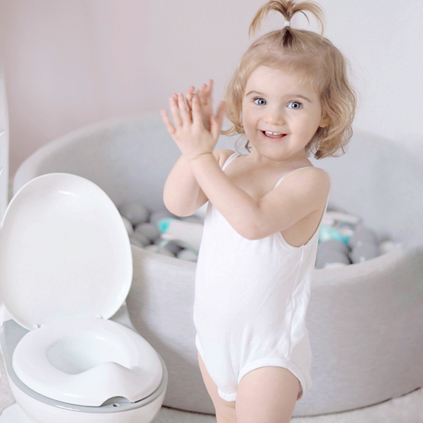It can seem challenging, but it’s something all parents face sooner or later: potty training is coming your way. Using a potty is a new skill for your child to learn. It's best to take it slow and go at your child's pace. Being patient with them will help them, even if you sometimes feel frustrated. Are you not quite sure how and when to tackle this? We’ll try and give you all the necessary information.
When is it time to pull out the potty?
The first question that pops in every parent’s head is when to start with potty training their little one. If you’re looking for a fixed age, we’ll have to disappoint you, because it can be different for each child. Children are able to control their bladder and bowels when they're physically ready and when they want to be dry and clean. Where one child can already do without diapers around the age of 2, for other children it takes until they are 5 years or older. You can try to work out when your child is ready by reading the signs. For example, they start to know when they’re peeing and may tell you they’re doing so, or they might be fidgeting or going somewhere quiet or hidden when they need to pee, or they start to notice when they’ve got a wet or dirty diaper. You can also ask yourself some questions. If the response is mostly yes, your kid might be ready.
- Can your child walk to and sit on a potty?
- Can your child pull down his or her pants and pull them up again?
- Can your child stay dry for up to two hours?
- Can your child understand and follow basic directions?
- Can your child communicate when he or she needs to go?
- Does your child seem interested in using the toilet or wearing "big-kid" underwear?
Your little one isn’t the only one that needs to be ready for this, you as a parent or caregiver have to be all set as well. Keep in mind that you can’t force a child. Try potty training when there are no great disruptions or changes to your child's routine. Some find it easier to start in the summer, when there are fewer clothes to take off and washed clothes dry more quickly. Also, keep in mind that accidents are inevitable, and punishment has no role in the process. Plan toilet training when you have the time and energy to be consistent for a longer period.
 Steps to take in potty training
Steps to take in potty training
Using a potty will be new to your child, so get them used to the idea gradually. There are a few things you can do to prepare:
- Talk to your little one about diaper changes so they understand all about pee and poo and what a wet diaper means.
- Place a potty in the bathroom or, initially, wherever your child is spending most of his or her time and explain what it's for. It helps to let your child see you using the toilet and explain what you're doing. A fun way to get them to see the similarities with what mum and dad are doing is by using the "My Real potty" training toilet. Using your child's toys to show what the potty is for can also help.
- Encourage your child to sit on the potty in clothes to start out. Make sure your child's feet rest on the floor or a stool.


 When you start with the real deal, here are some steps you should consider:
When you start with the real deal, here are some steps you should consider:
- Schedule potty breaks. Have your child sit on the potty without a diaper for a few minutes at two-hour intervals, as well as first thing in the morning and right after naps. For boys, it's best to learn to pee sitting down. Stay with your child and read a book together or play with a toy while he or she sits. Allow your child to get up if he or she wants. Even if your child simply sits there, offer praise for trying.
- Get there - Fast! When you notice signs that your child might need to use the toilet respond quickly. Help them become familiar with these signals, stop what he or she is doing, and head to the toilet. Praise your child for telling you when he or she has to go. Keep them in loose, easy-to-remove clothing.
- Explain hygiene. Teach your kid how to flush the toilet (and even use wipes) and make sure they wash their hands afterward. A fun way to teach them how grown-ups do it, is by using the "My real potty" training toilet with real-life flushing sound. Practicing using the flush: check! Practicing using wipes, double check!
- Take it with you everywhere. If you go out, take the potty with you, so your child understands that you'd like them to pee in the potty every time they need to go.
- Ditch the diapers. After a couple of weeks of successful potty breaks and remaining dry during the day, your child might be ready to trade diapers for training pants or underwear. They will be delighted when they succeed, so celebrate the transition! Let them return to diapers if they are unable to remain dry.
If things aren’t going quite as well and your little one isn’t a fan of his potty, take a break. Pushing your child when he or she isn't ready can lead to a frustrating power struggle. Try again in a few weeks or even months.
Staying dry at night
Night-time can be another challenge when it comes to potty training. It usually takes a little longer for children to learn to stay dry throughout the night. Some might learn this between the age of 3-5, others only stay completely dry at night at the age of 7. So, it’s important to make sure they are potty trained during the day before starting to leave off their diaper at night. If your child's diaper is dry or only slightly damp when he wakes for a few mornings in a row, he may be ready for night-time potty training.
You can potty train for the night by making sure the last thing they do before they go to sleep, is using the potty. Also make sure it's close by, so they can use it if they need to pee in the night. During the training, use disposable training pants and mattress covers when your child sleeps.
Accidents are inevitable
Accidents are bound to happen; no child is fully potty-trained overnight. If that does happen, just clean it up and try again. Stay calm and don't discipline or shame your child. If you do not make a fuss when they have an accident, they will not feel anxious and worried, and are more likely to be successful the next time. Put them in clothes that are easy to change and avoid clothes with zips or lots of buttons. Keep a change of underwear and clothing nearby, especially at school or in childcare.
If they seem ready for potty training but are having difficulties and keep having difficulties, talk to your child's doctor. He or she can give you guidance and check to see if there's an underlying problem.










